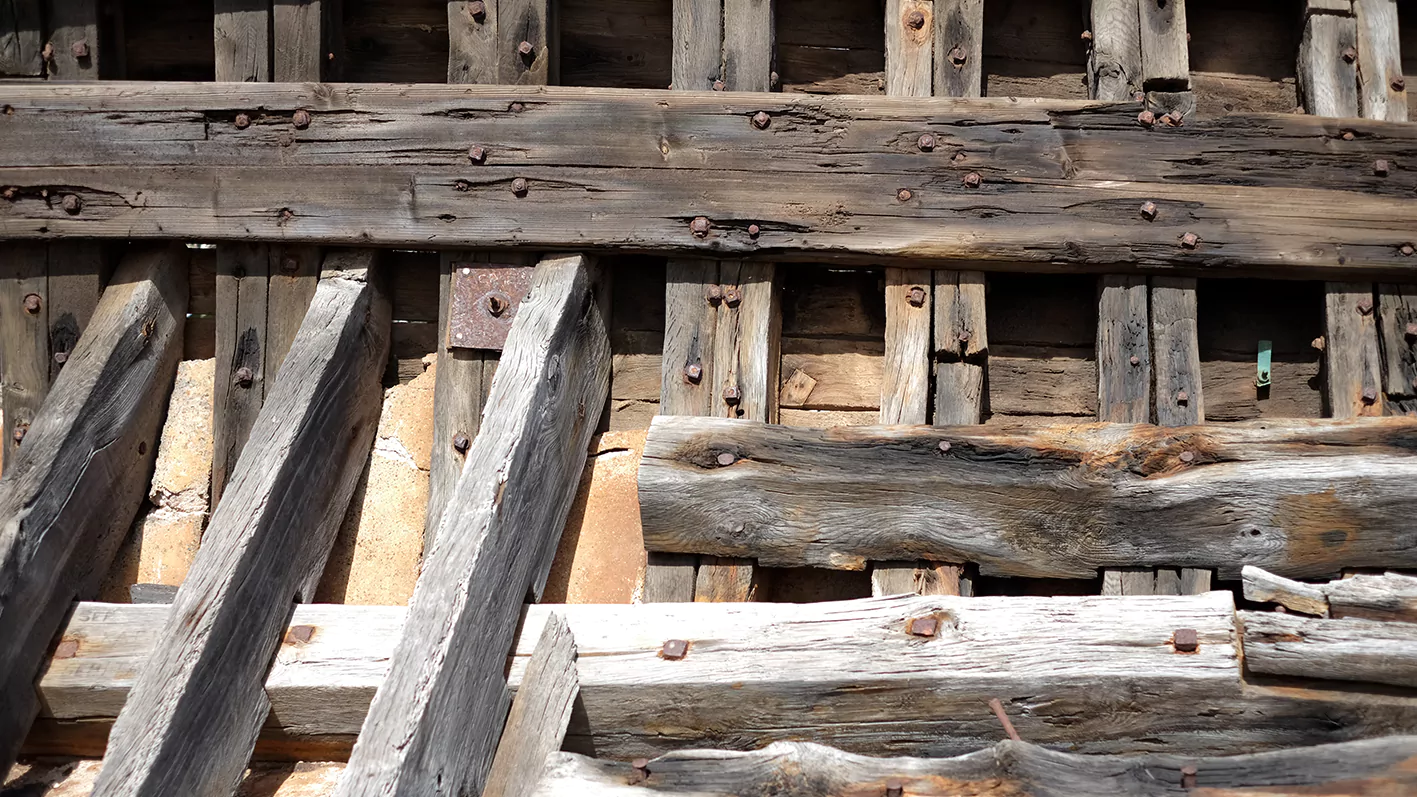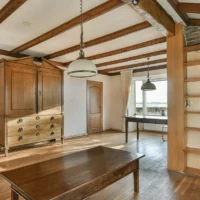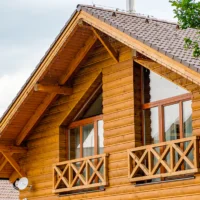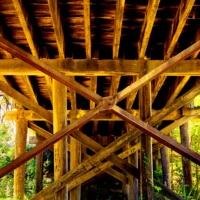Table of Contents
What Are Hand Hewn Wood Beams?
Hand hewn wood beams are structural and decorative timbers shaped manually with traditional tools such as axes and adzes. Instead of being processed through modern sawmills, these beams are carefully carved by hand, leaving behind tool marks that reflect centuries-old craftsmanship.
Definition: The Craft of Hewing Logs by Hand
The term “hewn” refers to the process of shaping round logs into square or rectangular beams by chopping and shaving away the wood surface. Craftsmen would peel bark from freshly cut trees and use broad axes to flatten the sides. This labor-intensive method creates beams that are strong, functional, and uniquely rustic in appearance.
Each hand hewn beam is distinct because the strokes of the craftsman’s tool create visible ridges and indentations, giving the timber a rich texture and character that machine-cut beams cannot replicate.
How Hand Hewn Beams Differ from Milled or Machine-Cut Beams
Machine-milled beams, while uniform and efficient, lack the individuality and historical charm of hand hewn wood beams. Milled beams have smooth, precise edges, but they appear manufactured and lack the subtle imperfections that give hand hewn beams their authenticity.
Hand hewn beams also carry a tactile quality—when you run your hand across the surface, you feel the grooves and marks left by tools. These imperfections are considered desirable because they highlight the craftsmanship and natural history of the wood.
History of Hand Hewn Beams in Traditional Timber Framing
Before sawmills became widespread in the 19th century, nearly all beams used in homes, barns, and civic structures were hand hewn. Timber framing relied heavily on this practice, as beams were essential for structural stability. Carpenters would spend hours preparing each beam, ensuring it fit snugly into mortise-and-tenon joints.
Historic log cabins, barns, and churches across North America and Europe still showcase hand hewn beams, proving their durability and long-lasting appeal. This centuries-old craft not only supported structures but also reflected the resourcefulness of early builders.
The History and Heritage of Hand Hewn Beams

Origins in Early American and European Architecture
Hand hewn wood beams date back to medieval Europe, where craftsmen relied on forests for building materials. Hewing was the primary way to transform logs into usable timbers for castles, cottages, and bridges.
When European settlers arrived in North America, they brought this tradition with them. Dense forests provided ample timber, and hand hewn beams became the backbone of early American log cabins and farmhouses. These beams were not only functional but also symbolic of craftsmanship, patience, and survival.
Role in Barns, Farmhouses, and Historic Structures
The role of hand hewn beams extended far beyond homes. They were widely used in barns, mills, and public buildings because of their strength and availability. The massive timbers could support heavy roofs and wide spans, making them perfect for agricultural and industrial structures.
Even today, many heritage barns and historic homes still stand strong with their original hand hewn beams intact. Their enduring quality demonstrates why early builders trusted this technique for their most important structures.
How Old-Growth Timber Adds Strength and Character
One of the reasons hand hewn beams remain so valuable is the type of wood originally used. Early builders relied on old-growth timber—trees that had grown undisturbed for hundreds of years. These trees developed tighter growth rings, resulting in denser, stronger wood compared to much of today’s lumber.
Old-growth timbers are less likely to warp or split, making them incredibly durable. When hewn by hand, they gain an added layer of authenticity and charm. The combination of natural density and handcrafted character makes these beams highly sought after for restoration projects and rustic home designs.
Benefits of Hand Hewn Wood Beams
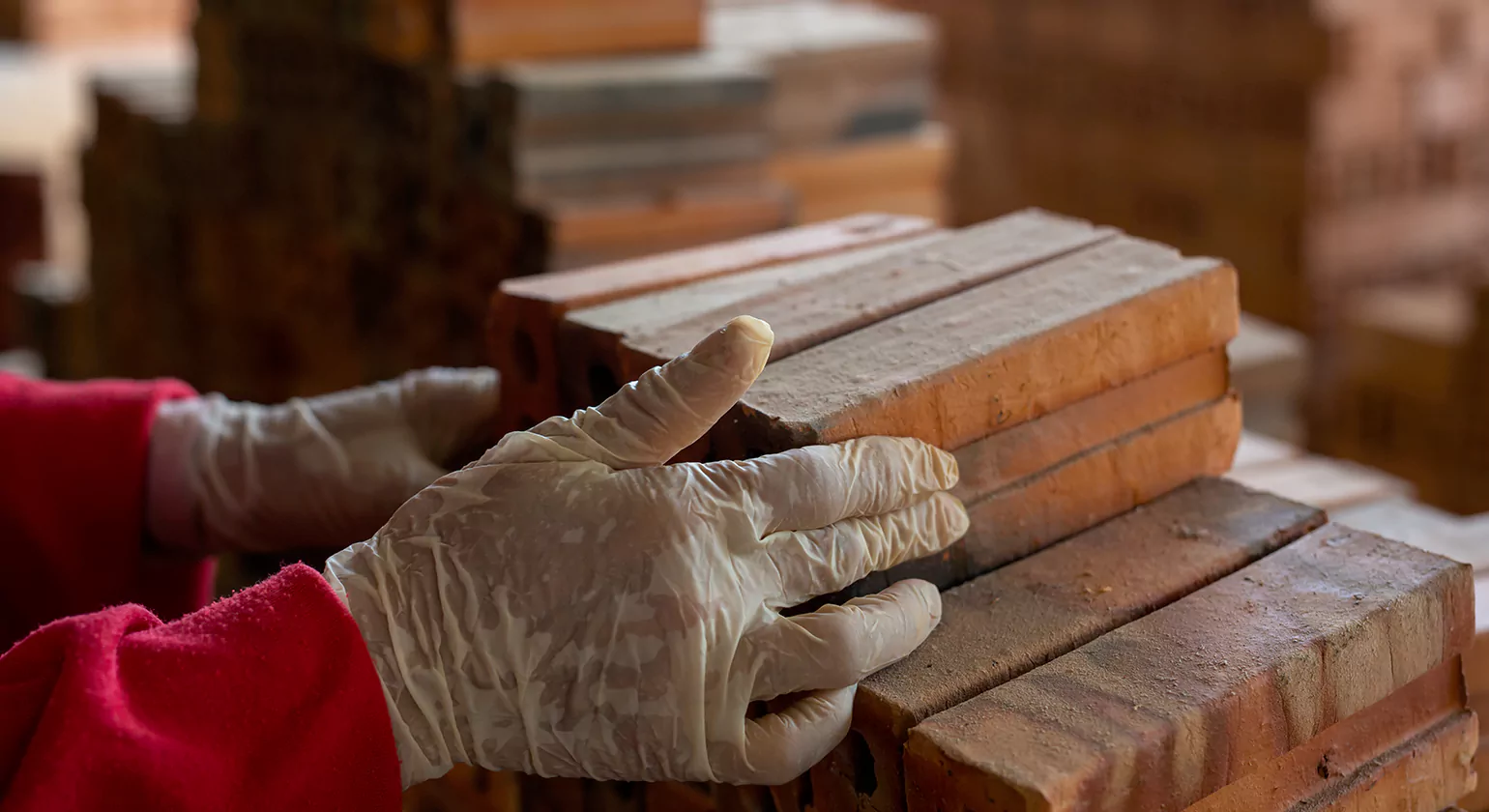
Unique Aesthetic: Natural Tool Marks and Patina
One of the greatest appeals of hand hewn wood beams is their authentic aesthetic. The marks left behind by broad axes and adzes create a rugged, handcrafted surface. Unlike smooth, machine-made lumber, each beam carries a story etched into its surface.
Over time, hand hewn beams develop a natural patina—a blend of weathering, oxidation, and age that deepens the wood’s color and character. This creates a warm, rustic look that blends seamlessly into farmhouse, cabin, or even modern industrial-style homes.
Whether left exposed in a ceiling or repurposed as mantelpieces, these beams add timeless charm that cannot be mass-produced.
Durability and Longevity of Aged Timber
Another advantage of hand hewn wood beams is their incredible durability. Many reclaimed beams today are hundreds of years old and still structurally sound. Old-growth timber, combined with the hewing process, produces beams that can withstand heavy loads and resist natural decay.
Builders often choose reclaimed hand hewn beams because they know these materials have already proven their strength over centuries. When properly maintained, they can last for generations, making them a smart long-term investment for both structural and decorative use.
Eco-Friendly: Reclaimed and Sustainable Materials
Sustainability is another key reason homeowners and designers choose hand hewn wood beams. By using reclaimed beams salvaged from old barns and historic buildings, builders reduce the need for new lumber harvesting. This practice gives new life to old timber while preserving forests for future generations.
Repurposing beams also minimizes waste. Instead of discarding old timbers, craftsmen carefully clean, treat, and recondition them for use in modern homes. This eco-friendly approach ensures that history is preserved while supporting sustainable building practices.
Adds Value to Rustic and Modern Homes
Finally, hand hewn wood beams significantly increase the value of a property. Whether incorporated as ceiling beams, fireplace mantels, or accent pieces, they create a sense of warmth and sophistication that buyers appreciate.
In rustic homes, they highlight authenticity and tradition. In modern homes, they provide striking contrast against sleek finishes, blending old-world craftsmanship with contemporary design. This versatility makes hand hewn beams an ideal feature for homeowners seeking both style and long-term investment value.
Hand Hewn Beams vs. Reclaimed vs. Faux Beams
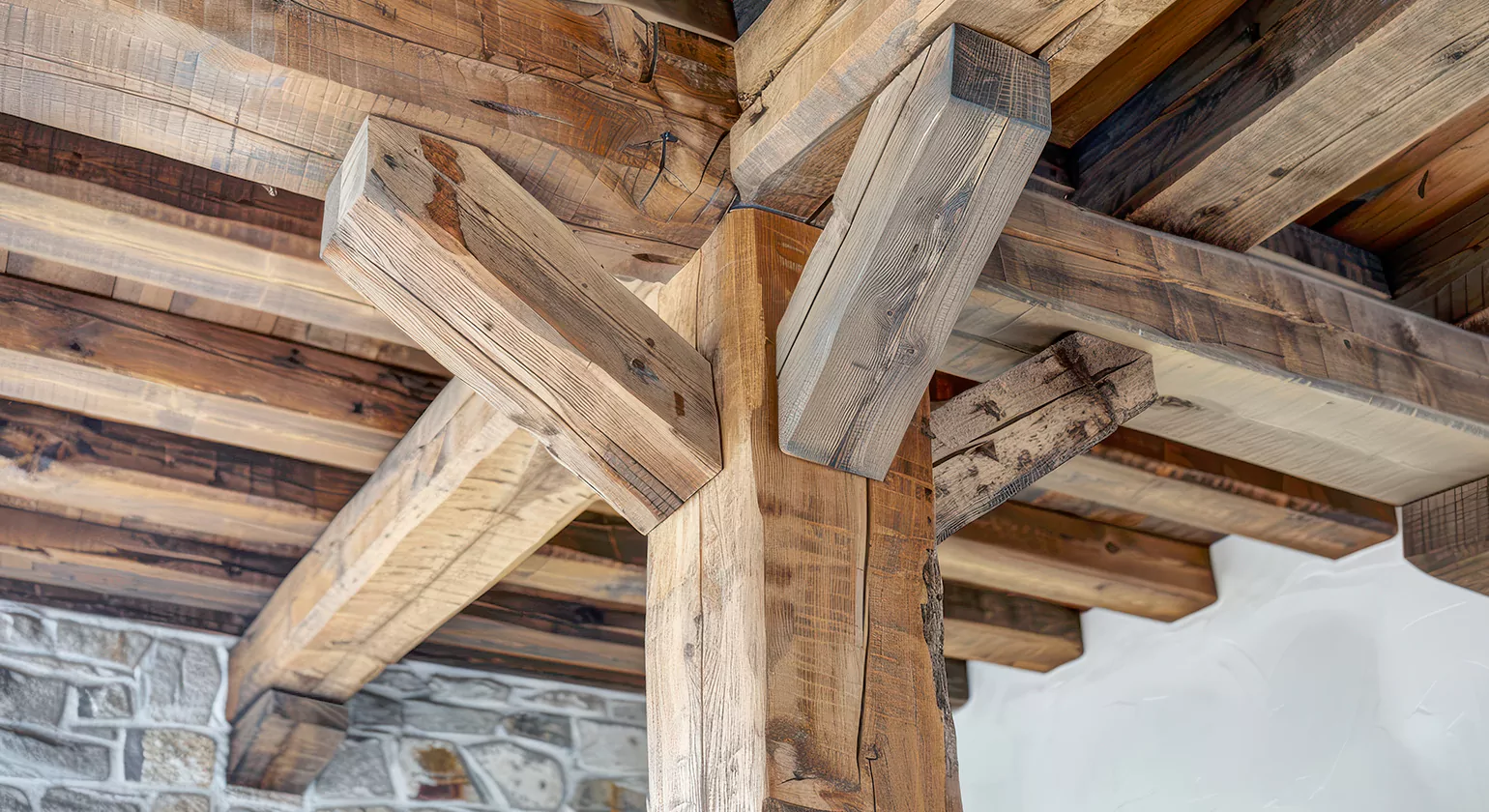
When exploring design options for your home, it’s important to understand the different types of beams available: authentic hand hewn beams, reclaimed beams, and faux hand hewn beams. Each has unique qualities that suit different budgets, aesthetics, and project needs.
Difference Between Authentic and Reclaimed Beams
Authentic hand hewn wood beams are timbers shaped manually from freshly cut logs using traditional tools such as axes and adzes. These beams showcase the raw marks of craftsmanship and often come from newly harvested timber, although some are custom-made using traditional methods.
On the other hand, reclaimed hand hewn beams are salvaged from old barns, warehouses, or historic buildings. They carry decades or even centuries of history, often made from old-growth timber that is no longer widely available today. Their patina, aged color, and weathered texture make them highly desirable for rustic or restoration projects.
While both authentic and reclaimed beams share the unique tool marks of hand hewing, reclaimed beams come with added environmental and historical value.
Pros & Cons of Faux Hand Hewn Beams (Lightweight Alternatives)
Faux hand hewn beams are crafted from polyurethane or other lightweight materials designed to mimic the look of real hand hewn wood beams. These beams are hollow, lightweight, and easy to install, making them a cost-effective choice for homeowners who want the rustic look without the weight or expense of authentic timber.
Pros of faux beams
- Lightweight and easy to install without structural reinforcements
- Affordable compared to authentic or reclaimed beams
- Available in consistent sizes and finishes
Cons of faux beams
- Lack the authenticity and tactile quality of real hand hewn beams
- Cannot provide structural support
- Over time, may not age as gracefully as genuine timber
For purely decorative purposes, faux beams are a smart choice. However, for structural integrity and authentic character, real hand hewn wood beams or reclaimed beams remain superior.
When to Choose Reclaimed vs. New Hewn Beams
Deciding between reclaimed and newly hewn beams depends on your project’s priorities:
- Choose reclaimed beams if you value history, sustainability, and authentic aged patina. They are ideal for restoration projects, historic homes, or rustic designs that celebrate natural imperfections.
- Choose new hand hewn beams if you need custom dimensions, consistent structural integrity, or want beams that blend rustic craftsmanship with modern design requirements.
Both options add incredible character, but reclaimed beams connect you directly to the past, while new beams offer flexibility and modern reliability.
Common Uses of Hand Hewn Wood Beams in Homes
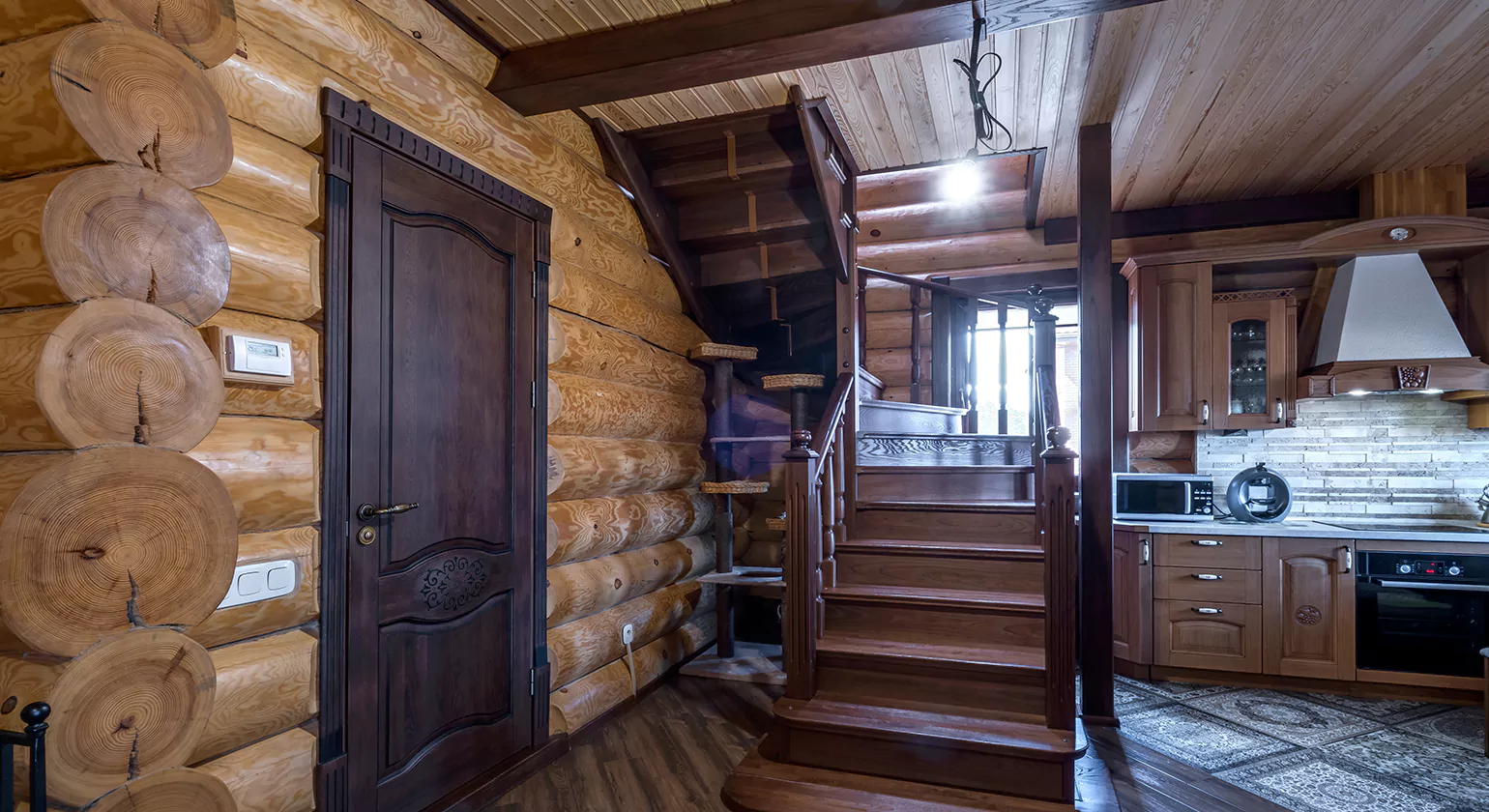
Hand hewn wood beams are prized not only for their craftsmanship but also for their versatility. They can be used structurally or decoratively to enhance a wide range of spaces.
Structural Timber Framing Applications
In traditional construction, hand hewn beams were primarily structural. They formed the skeleton of barns, cabins, and large timber-frame homes. Even today, builders use hand hewn wood beams in post-and-beam construction and timber framing, where strength and authenticity are equally important.
Exposed hand hewn beams in structural framing make a bold architectural statement while ensuring durability for decades.
Decorative Exposed Ceiling Beams
Perhaps the most popular modern use of hand hewn beams is as exposed ceiling beams. Whether spanning across a vaulted ceiling in a great room or creating a cozier feel in a farmhouse kitchen, these beams add warmth and rustic charm.
Even in modern or minimalist homes, exposed hand hewn wood beams create contrast, grounding sleek interiors with natural texture. Designers often combine recessed lighting or chandeliers with beams to highlight their unique surface and tool marks.
Mantels, Posts, and Interior Accents
Hand hewn beams are also commonly repurposed as fireplace mantels, interior posts, and accent pieces. A thick, reclaimed hand hewn beam above a fireplace instantly becomes a focal point, adding depth and history to the room.
Vertical beams can serve as rustic columns or partitions, while smaller sections can be used as shelves or trim. These accents allow homeowners to integrate the beauty of hand hewn wood beams without major structural changes.
Outdoor Uses: Porches and Garden Structures
Outdoors, hand hewn wood beams are frequently used for porch posts, pergolas, and garden structures. Their rugged durability allows them to withstand the elements, while their aesthetic blends perfectly with natural landscapes.
Whether framing a covered porch or supporting an outdoor pavilion, these beams provide both function and timeless design. Reclaimed beams, in particular, offer added weather resistance thanks to their aged and seasoned qualities.
How Hand Hewn Beams Are Made
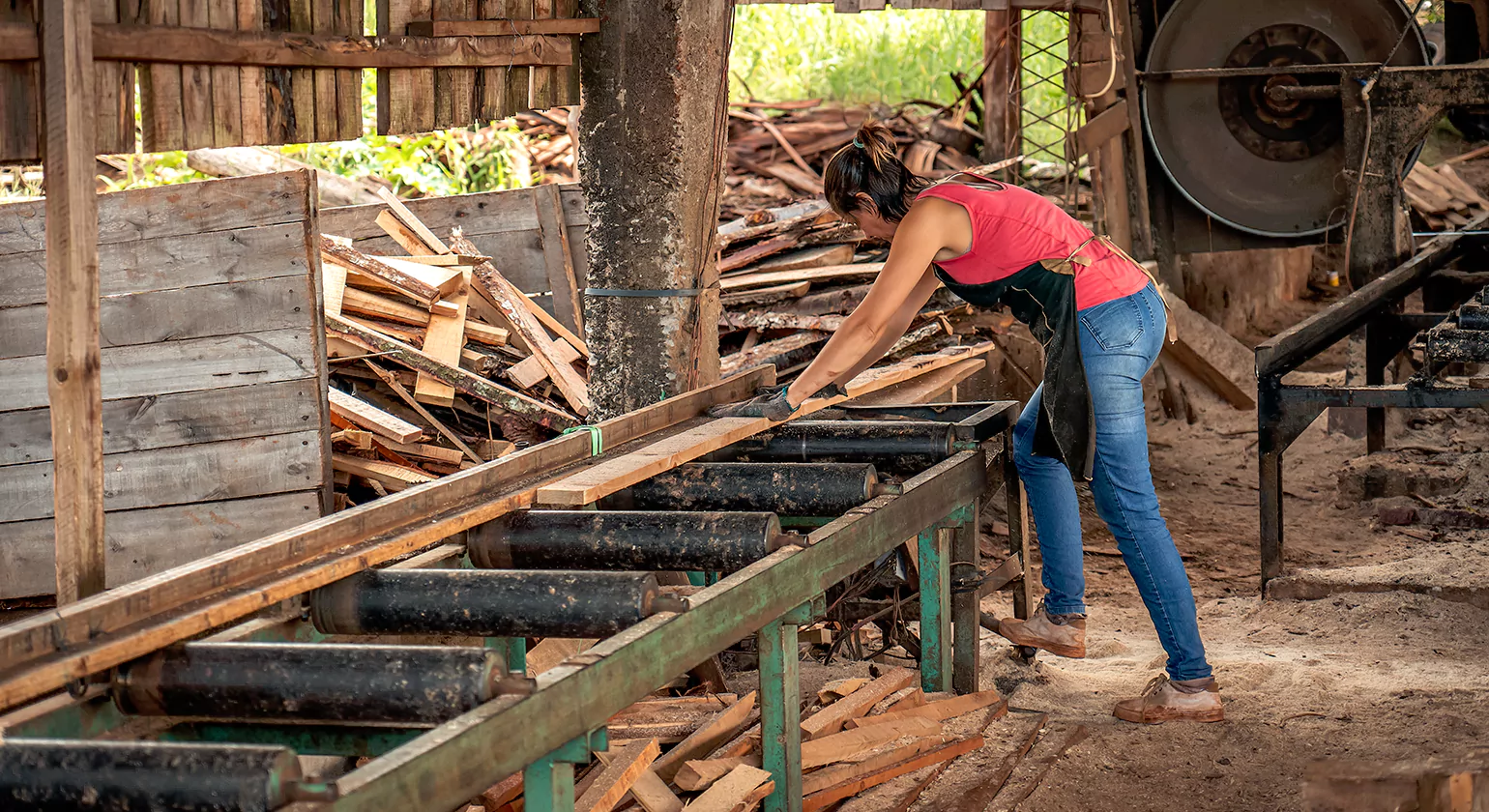
The making of hand hewn wood beams is a process steeped in tradition. While modern reproductions exist, the fundamental craft of hewing remains a skilled art.
Traditional Hewing Process: Axe, Adze, and Broad Axe Techniques
Traditionally, craftsmen would select a straight, tall log—often from oak, chestnut, or pine—and strip off the bark. Using a broad axe, they would score the log lengthwise with shallow cuts. Then, by swinging the axe downward, they would remove large sections of wood, flattening one side at a time.
An adze, a tool with a curved blade, was often used for finer smoothing and shaping. This method required significant physical strength and precision, as beams needed to be uniform enough to fit into timber-frame joints.
The resulting beams were strong, functional, and full of character. Every mark left by the axe and adze told a story of the craftsman’s hand and effort.
Modern Reproductions and Custom Fabrication
Today, some beams are still hand hewn using traditional methods, especially for restoration projects or clients seeking authenticity. However, modern workshops may also replicate the look of hand hewing using power tools, chisels, and distressing techniques.
Custom fabricators can create new hand hewn wood beams in specific dimensions, wood types, and finishes to suit contemporary design needs. While these beams may not always carry centuries of history, they still offer the rustic aesthetic and individuality of the craft.
Finishing Styles: Rough Hewn vs Smoothed Hewn
Once a beam is hewn, it can be finished in different styles depending on the desired look:
- Rough hewn beams retain more visible axe marks, irregularities, and texture. They are ideal for rustic cabins, barns, and farmhouse-style interiors.
- Smoothed hewn beams are lightly sanded or planed, softening tool marks while still preserving handcrafted character. These beams work well in transitional or modern rustic homes.
Finishing may also involve applying stains, oils, or sealants to enhance color, protect the wood, and bring out the natural grain. Whether left raw or finished, hand hewn beams always retain their organic charm.
Design Ideas with Hand Hewn Wood Beams
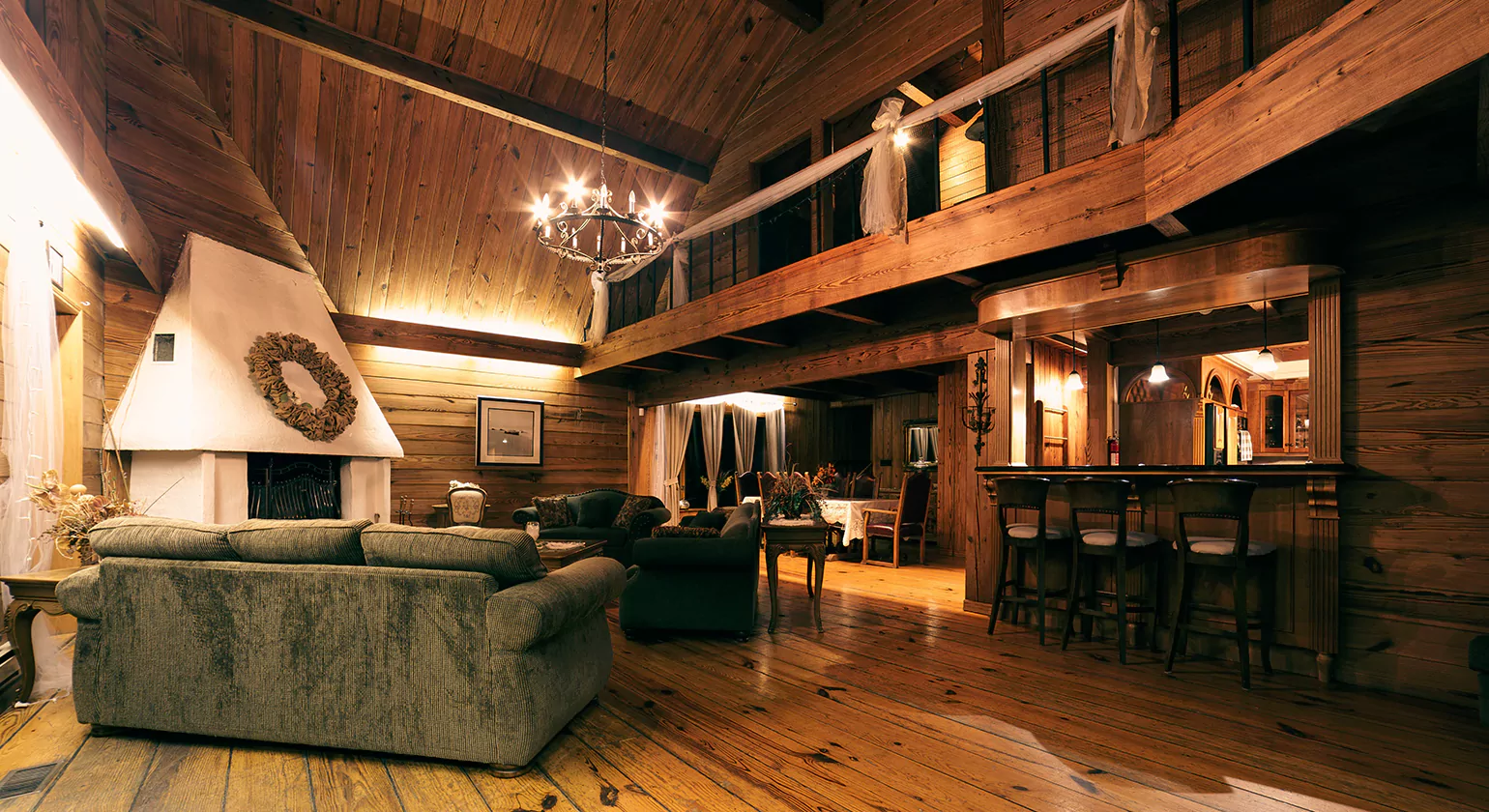
Hand hewn wood beams aren’t limited to rustic cabins or barns — they can complement a wide range of design styles, from traditional farmhouses to modern industrial lofts. Their versatility makes them one of the most sought-after architectural features in both residential and commercial spaces.
Rustic Farmhouse Style Interiors
One of the most popular ways to use hand hewn wood beams is in farmhouse-style interiors. In this setting, beams bring warmth, texture, and authenticity to kitchens, dining rooms, and living spaces. Paired with shiplap walls, wide-plank flooring, and vintage furniture, exposed beams create the inviting atmosphere farmhouse design is known for.
Rustic farmhouse interiors often incorporate reclaimed hand hewn beams with visible tool marks and aged patina. These elements tell a story of history and craftsmanship while giving the home a lived-in, cozy feel.
Modern Industrial with Timber and Steel
Surprisingly, hand hewn wood beams also work beautifully in modern industrial designs. When combined with steel, glass, and concrete, the rough-hewn timber adds organic contrast to sleek, minimalist elements. For example, exposed beams in an industrial loft soften the harshness of metal railings and polished concrete floors.
Pairing dark-stained hand hewn beams with black steel brackets or accent hardware emphasizes the blend of old-world craftsmanship and contemporary urban design. This fusion creates a unique look that appeals to homeowners who want something both modern and timeless.
Blending Beams with Stone Fireplaces
Few design combinations are as striking as hand hewn beams paired with natural stone fireplaces. A massive reclaimed beam used as a mantel above a rugged stone hearth creates a focal point that embodies strength, tradition, and rustic elegance.
This pairing works equally well in log cabins, mountain lodges, and luxury suburban homes. The organic textures of wood and stone complement each other, reinforcing a connection to nature while adding warmth and dimension to interior spaces.
Open Floor Plans and Vaulted Ceilings
In homes with open floor plans and vaulted ceilings, hand hewn wood beams provide definition and structure. They can span wide spaces, visually dividing living, dining, and kitchen areas without the need for walls.
Beams in vaulted or cathedral ceilings draw the eye upward, emphasizing the height and spaciousness of the room. Whether arranged in a simple parallel design or in a more complex truss pattern, hand hewn beams create a dramatic architectural feature that enhances modern open-concept living.
Maintenance and Care of Hand Hewn Beams
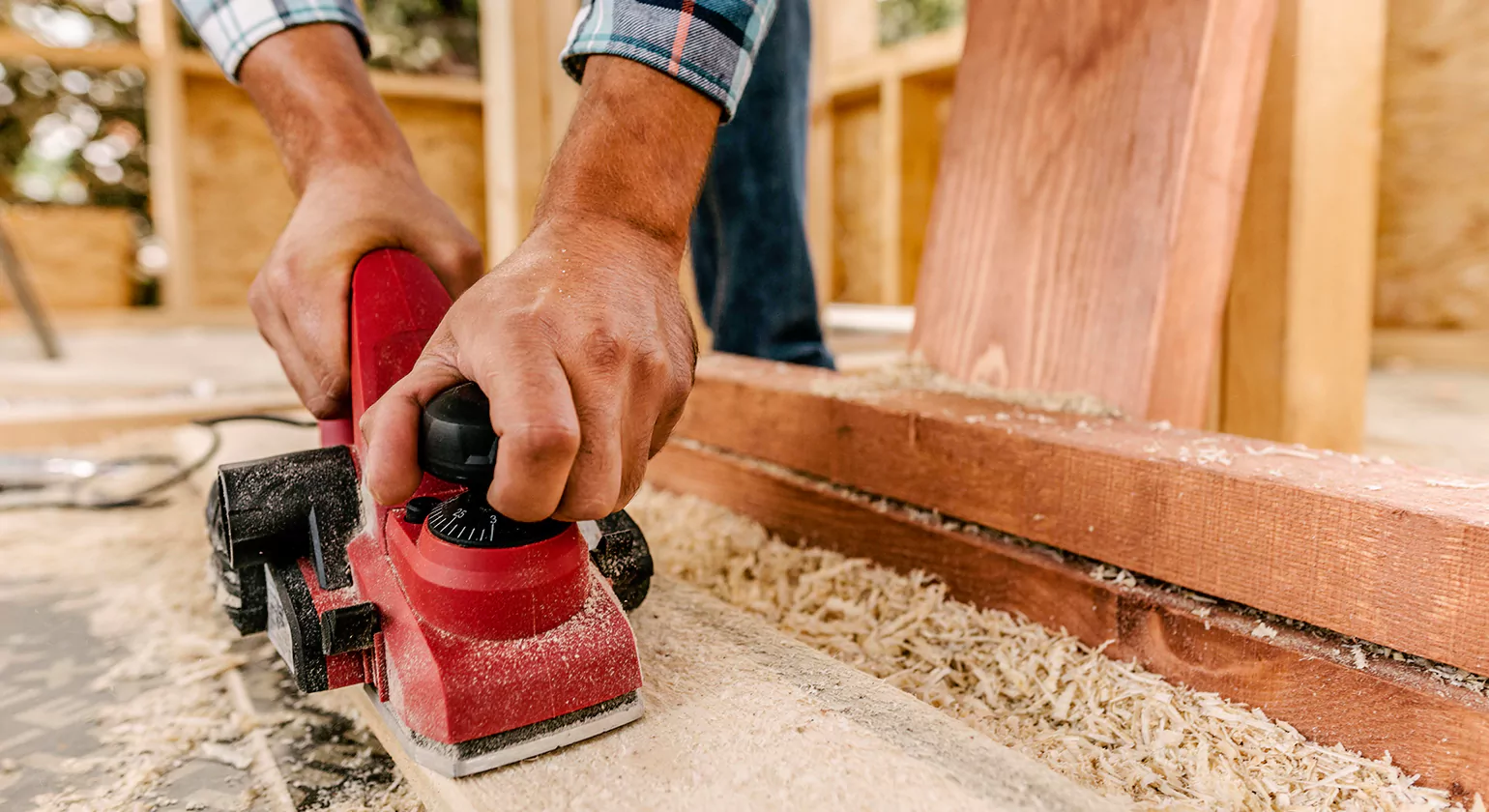
While hand hewn wood beams are remarkably durable, proper maintenance ensures they remain strong and beautiful for generations. Care strategies depend on whether beams are structural or purely decorative, as well as whether they are located indoors or outdoors.
Preventing Rot, Insects, and Moisture Damage
The biggest threats to hand hewn beams are rot, insect infestations, and moisture exposure. To prevent these issues:
- Inspect regularly for cracks, soft spots, or sawdust-like residue that could indicate pests.
- Apply protective finishes such as natural oils, waxes, or low-sheen sealants to reduce moisture absorption.
- Ensure proper ventilation in attics, basements, or outdoor areas to avoid damp conditions.
For reclaimed beams, it’s especially important to have them treated for pests before installation. Many suppliers kiln-dry and clean beams to eliminate insects and fungi, ensuring the timber is safe for long-term use.
Cleaning and Refinishing Beams Without Losing Patina
One of the charms of hand hewn wood beams is their natural patina and tool marks. Over-cleaning or sanding can erase these historic details. Instead, use gentle methods:
- Dust beams with a soft brush or vacuum with a bristle attachment.
- For deeper cleaning, lightly wipe with a damp cloth — but avoid soaking the wood.
- When refinishing, choose breathable oils or waxes rather than heavy polyurethane. These finishes nourish the wood while preserving its natural aged look.
If beams develop stains or discoloration, a professional wood restorer can carefully clean them without compromising their character.
Structural vs Decorative Beam Maintenance
Structural hand hewn beams carry load-bearing responsibilities, so regular inspections are critical. Look for signs of splitting, sagging, or rot that could compromise strength. In older homes or barns, professional evaluation by a timber-frame expert is recommended.
Decorative beams, by contrast, face less risk. Maintenance is primarily about preserving their aesthetic appeal rather than structural integrity. Occasional cleaning and protective finishes are usually sufficient to keep them in excellent condition.
Where to Source Hand Hewn Wood Beams
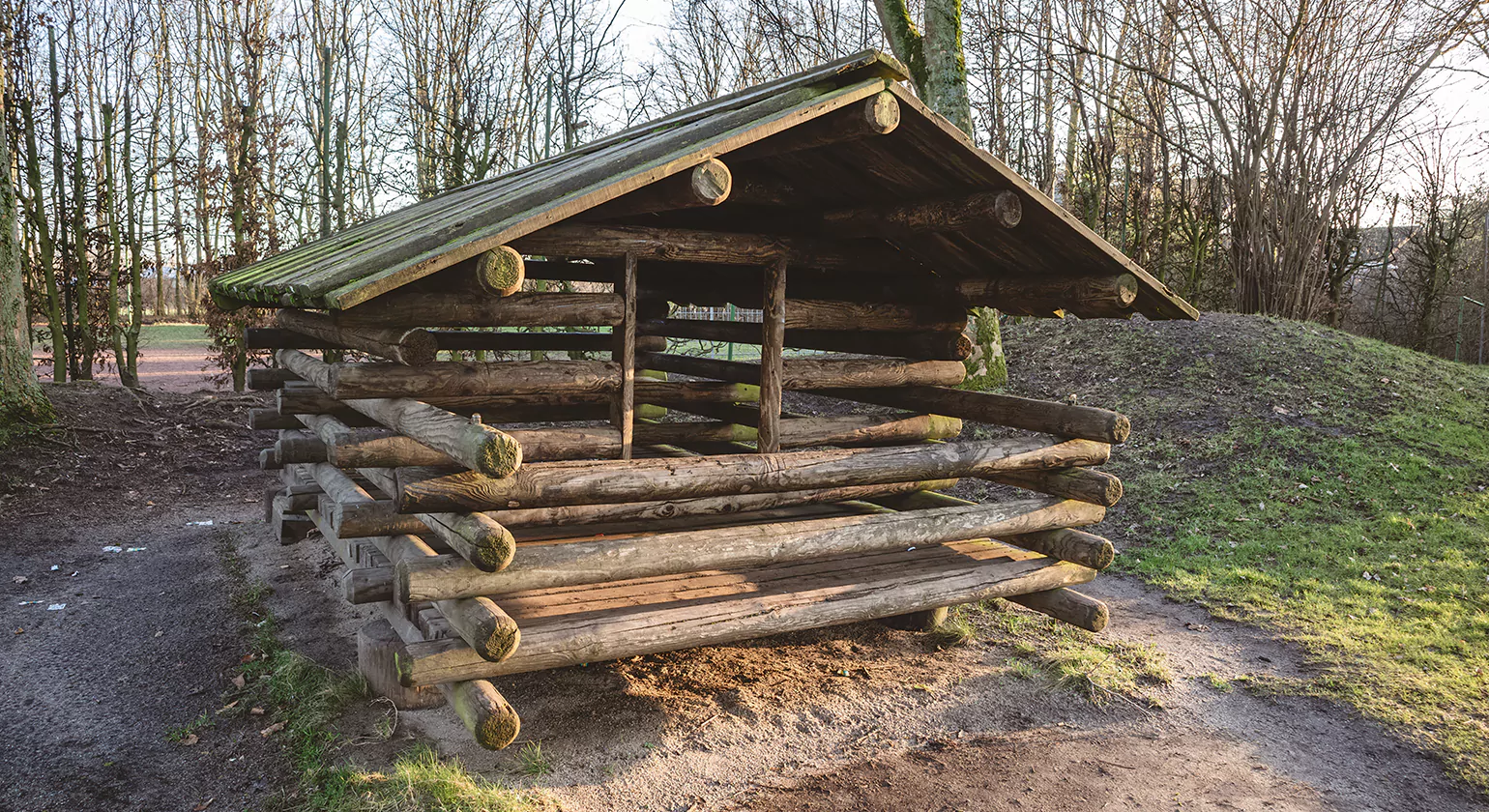
Finding the right hand hewn wood beams for your project requires understanding where to source them. Whether you’re seeking reclaimed beams with centuries of history or new beams crafted in traditional style, a variety of options exist.
Salvage Yards and Barn Demolitions
One of the most authentic sources for reclaimed hand hewn beams is salvage yards or barn demolitions. Many barns, warehouses, and old farmhouses across North America and Europe contain original hand hewn timbers. When these structures are dismantled, the beams are salvaged, cleaned, and resold for new construction or design projects.
The advantage of beams from barn demolitions is their authenticity and unique character. However, supply is limited, and dimensions can vary widely, so availability may not always match specific design needs.
Specialty Timber Frame and Reclaimed Wood Suppliers
For consistency and reliability, many homeowners turn to specialty timber suppliers. These businesses focus on sourcing, restoring, and selling reclaimed beams or crafting new hand hewn beams using traditional methods.
Suppliers often kiln-dry reclaimed beams to remove pests and moisture, then offer custom finishing options. They may also fabricate beams to specific dimensions, ensuring they meet modern building codes and project requirements.
Working with a reputable supplier ensures you receive quality beams that are structurally sound, safe, and ready for installation.
Cost Factors: Age, Size, and Provenance of Beams
The cost of hand hewn wood beams varies significantly based on several factors:
- Age: Reclaimed beams are often more expensive due to their historical value and patina.
- Size: Larger beams require more labor to hew and are rarer in reclaimed markets, increasing cost.
- Provenance: Beams with documented origins (e.g., from a historic barn or landmark) can carry a premium price.
On average, reclaimed hand hewn beams may cost more per linear foot than newly crafted beams, but their uniqueness and sustainability often justify the investment. Faux beams, while more affordable, cannot match the authenticity of real hand hewn timber.
Conclusion
Hand hewn wood beams are more than just architectural elements—they are enduring symbols of craftsmanship, history, and natural beauty. From their origins in early European and American timber framing to their modern use in rustic farmhouses, industrial lofts, and open-concept homes, these beams bring authenticity and warmth to any space. Whether reclaimed for their aged patina and sustainability, newly crafted for custom projects, or used as decorative accents like mantels and ceiling beams, they offer unmatched character and value. With proper care to prevent moisture, pests, and wear, hand hewn wood beams can last for generations, making them both a design statement and a lasting investment that blends tradition with contemporary style.
Know more>>> Structural Wood Beams: Types, Sizes, Load Charts, Cost & Installation Guide
FAQ’S
1. What is a hand hewn beam?
A hand hewn beam is a timber that has been shaped manually from a raw log using traditional tools like axes and adzes, rather than cut by machines. This process leaves visible tool marks, giving the beam a rustic, handcrafted appearance that’s highly valued in both structural and decorative applications.
2. Are hand hewn beams stronger than milled beams?
Hand hewn beams, especially those made from old-growth timber, are often stronger and more durable than modern milled beams. The density of historic wood, combined with the careful craftsmanship of hewing, makes them resistant to warping and splitting, which contributes to their long-lasting structural integrity.
3. How old are reclaimed hand hewn beams usually?
Reclaimed hand hewn beams are typically 100 to 200 years old, often salvaged from barns, farmhouses, and industrial buildings dating back to the 18th and 19th centuries. Their age gives them a rich patina and character that can’t be replicated in newly milled or faux beams.
4. Can hand hewn beams be used decoratively?
Yes, hand hewn beams are commonly used decoratively as exposed ceiling beams, fireplace mantels, posts, shelving, and accent pieces. While some beams are structural, many are installed purely for aesthetic purposes, adding warmth, rustic charm, and authenticity to interiors.
5. What’s the cost of authentic hand hewn wood beams?
The cost of authentic hand hewn wood beams varies based on age, size, condition, and provenance. On average, reclaimed beams may range from $10 to $30 per linear foot, with rare or historic pieces costing more. Faux beams are generally cheaper, but they lack the authenticity of real timber.
6. How do you clean and maintain hand hewn beams?
To maintain hand hewn beams, dust them regularly with a soft brush, vacuum with a bristle attachment, and avoid harsh chemicals. For deeper care, apply natural oils or waxes to nourish the wood without losing its patina. Structural beams should be inspected for moisture, pests, or cracks to ensure long-term durability.
7. Are faux hand hewn beams worth it?
Faux hand hewn beams can be worth it for lightweight, affordable, and easy-to-install decorative applications. While they mimic the look of real beams, they provide no structural support and lack the authentic texture and history of genuine hand hewn wood beams. They are best suited for projects where cost or weight is a concern.

